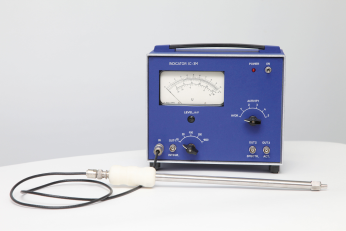CAVITOMETER
Designation
Cavitometer (cavitation meter) is designed to measure and control the cavitation activity in high-power ultrasonic fields and hydrodynamic cavitometers (cavitation meters).
This device can be used to optimize the ultrasonic processes, determining the presence and intensity of cavitation in hydraulic systems, cavitation threshold measurement.
Spheres of application
- Operation modes control and optimization in the purification, impregnation, preparation and handling suspensions processes, in particular nanoparticles suspensions; emulsions receipt and processing; crystallization; degassing liquids and other
- Sonochemical reactions acceleration
- Increase the reactivity of metal surfaces
- High-molecular compounds destruction (depolymerization)
- Catalytic effect in reactions with powders (e.g., catalytic action of nickel powder can be enhanced by ultrasound on several orders of magnitude)
- Paraffins cracking of into small pieces at room temperature
- Increase the exit rate to the Ullmann and Wurtz reaction and other reactions.
- Increasing the permeability of cell membranes (sonoporation) without a significant impact on the cell life
- The suppression of cell growth and reproduction
- Destruction of cells without the possibility of recovery functions.
- Study of the cavitation zone generation and dynamics peculiarities in different environments and under different conditions.
Specifications
| The frequency range of ultrasonic field generating cavitation, kHz | 10...50 |
| The range of cavitation noise spectral analysis, MHz | 0,01...10 |
| Cavitating liquid temperature range, °Ñ | 5...100 |
| Sensor diameter, mm | 6 |
| Sensor full length (hydrophone), mm | 300 |
| Sensor waveguide material | stainless steel. |
| Supply voltage, V, Hz | 220, 50...60 |
| Unit of measurement | rel. u. |
According to Customer specifications for the production of special sensors and cavitometers (cavitation meters) particularly high-temperature or high-frequency ones can be provided.
High temperature cavitometer (cavitation meter) allows measuring the activity of cavitation in the metal melts at temperatures up to 1000 °Ñ.
High frequency cavitometer (cavitation meter) is designed for measuring activity of cavitation ultrasonic fields with a frequency of 0,5…4 MHz.
Operating principle
Acoustic signal generated by the cavitation area (cavitation noise) is received by a device sensor and converted to electric signal. The latter is processed by the electronic control unit then the value of cavitation activity is displayed on the indicator.
The resulting values are a source parameter to the control and manage technological processes or the degree of ultrasound influence on biological structures.
On the physical measuring principle of cavitation you can read here.
The basic model has the following measurement modes:
- Total cavitation activity;
- Nonstationary cavitation activity;
- Nonstationary cavitation activity classified by intensity collapse;
- Full sound pressure (using a calibrated sensor).
Package Includes
Cavitometer (cavitation meter) – 1 pc.
Sensor – 1 pc.
User manual – 1 copy.
Delivery Terms and Conditions
Cavitometer (cavitation meter) Delivery Terms and Conditions are defined by the delivery / development contract.
"Product" delivery date is the date of its transfer to the Customer or Carrier (using express mail service).
"Product" delivery is made with one party in no more than 20 calendar days after advance payment enrollment in the Contractor bank account.
Warranty
Warranty service is 12 months from the date of delivery (in accordance with the Waybill).






